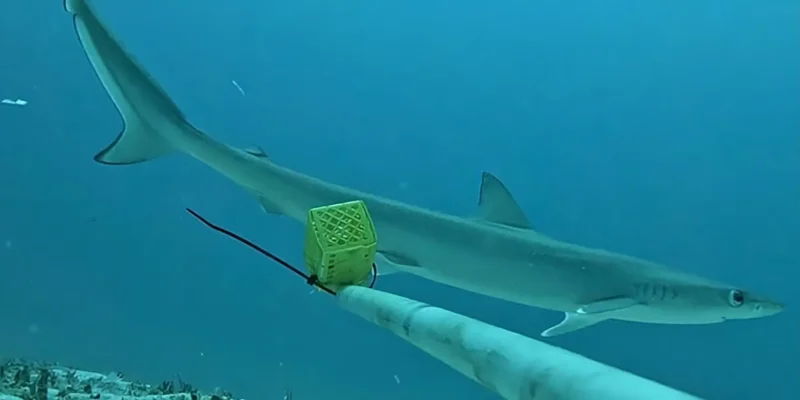On the Great Chagos Bank, the largest coral atoll structure in the world, the sliteye shark (Loxodon macrorhinus) has been documented for the first time. The discovery expands the known range of this near-threatened species and highlights the ecological importance of the Chagos Archipelago and its vast marine protected area.
Deep seagrass meadows as a hotspot of biodiversity
The most recent sightings were made in previously unexplored seagrass meadows on the southern edge of the Great Chagos Bank. Two individuals were recorded just 11 kilometers apart at depths of 23 to 29 meters—using BRUV systems (Baited Remote Underwater Video), which attract and record marine animals without human disturbance.
Named after its narrow, slit-like eyes, the sliteye shark is adapted to low light and thrives both in deeper, dim zones and in clear shallow waters. Given its wide distribution range, researchers consider it unlikely that the species is rare in the Chagos Archipelago.
“The discovery of the sliteye shark in the Chagos Archipelago was incredibly exciting. It shows how much we still have to learn about deep-sea seagrass ecosystems and their role in marine biodiversity – especially in remote regions of the Indian Ocean.” – Charlotte Oulton, Swansea University
Chance discovery: extensive seagrass meadows at 25–30 meters depth
The extensive seagrass meadows were discovered when researchers were actually tracking the migrations of green sea turtles via satellite. What was surprising was not only the depth of 25 to 30 meters, but also the diversity of the habitat: more than 110 fish species and now also the sliteye shark use the meadows as an oasis of food and a refuge.
Conservation needs of a species under pressure
For the sliteye shark, a population decline of up to 29% is projected over the next 15 years – mainly due to fishing pressure. The current record raises important questions about abundance, habitat use, and conservation priorities, and highlights the urgency of specifically researching and protecting deeper habitats.
Joint project for mapping and habitat modeling
The findings come from surveys conducted at the end of 2024 and are part of a joint project between Swansea University and international partners, funded by the Bertarelli Foundation (Indian Ocean Marine Science Programme). The goals are to map the current seagrass coverage, model suitable habitats, and assess the ecological importance of these deep-sea seagrass ecosystems across the entire archipelago.
Large protected areas work – example Chagos
A new study shows that large marine protected areas can effectively protect migratory species such as sea turtles, manta rays, and seabirds over wide parts of their life cycle. The protected area in the Chagos Archipelago currently covers 640,000 km².
“Very large marine protected areas are central to achieving international goals such as 30% protection by 2030. Our results demonstrate the value of the VLMPA in the Chagos Archipelago for protecting a wide range of large, mobile marine species.” – Dr. Alice Trevail, University of Exeter
What the sovereignty change means
With the expected transfer of the Chagos Archipelago to Mauritius, the results of both studies gain additional relevance. They not only provide strong evidence for the value of the protected area but also identify priority zones for long-term conservation to secure the future of marine megafauna.




